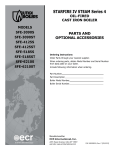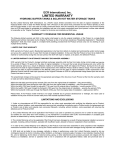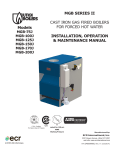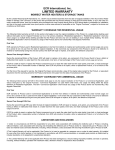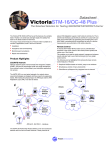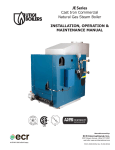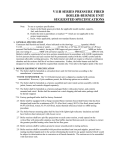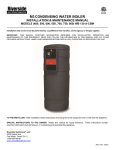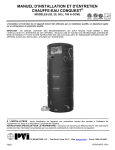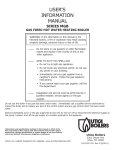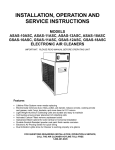Download Utica Boilers SFE IV Steam Operation and Installation Manual
Transcript
STARFIRE IV STEAM Series 4 MODELS SFE-3090S SFE-3090ST SFE-4125S SFE-4125ST SFE-5185S SFE-5185ST SFE-6210S SFE-6210ST OIL-FIRED CAST IRON BOILER INSTALLATION, OPERATION & MAINTENANCE MANUAL PATENT 7,823,544 Manufactured by: ECR International, Inc. 2201 Dwyer Avenue, Utica NY 13501 web site: www.ecrinternational.com An ISO 9001-2008 Certified Company P/N 240009806, Rev. B [03/2014] DIMENSIONS Figure #1 DIMENSIONS Boiler No. SFE-3090 SFE-4125 SFE-5185 SFE-6210 Front of Jacket Length of Flush to Center Line of Flue Outlet Diameter Jacket Flue Outlet -A-B-C- 16⅜" 20¼" 23⅝" 27½" 6½" 8½" 10¼" 85/₁₆" 6" 6" 7" 8" STANDARD EQUIPMENT: Crated boiler, flush jacket, oil burner, target wall/liner, safety valve, steam water level gauge, steam pressure gauge, steam pressure control, low water cut-off, drain valve, wiring harness, burner electric disconnect, plastic cover, 2" supply tapping, 1½" return tapping, skim port, and primary control. (NOTE: For tankless heater units, add tankless hot water coil, and low limit control.) 2 RATINGS, DATA RATINGS Boiler Model Number Oil Burner Input(1) WITHOUT TANKLESS WITH TANKLESS G.P.H. MBH(2) Heating Capacity MBH(4) SFE-3090S SFE-3090ST 0.90 126 SFE-4125S SFE-4125ST 1.25 SFE-5185S SFE-5185ST SFE-6210S SFE-6210ST Net AHRI Ratings(3) Min. Natural Draft Chimney Size A.F.U.E. Rating(4) Steam MBH Sq. Ft. Steam Round Square 106 80 333 6 8"x8"x15' 82.0 175 147 110 458 6 8"x8"x15' 82.0 1.85 259 216 162 675 8 8"x8"x15' 82.0 2.10 294 247 185 771 8 8"x8"x15' 82.0 NOTES: (1) Burner input is based on an oil heating value of 140,000 Btu/gal. (2) MBH = 1000 Btu per hour [Btu =British Thermal Unit]. (3) Net AHRI Steam Ratings based on piping and pick-up allowance of 1.333. Consult manufacturer before selecting boiler for installations having unusual piping and pick-up requirements, such as intermittent system operation, extensive piping, etc. (4) Heating Capacity and AFUE based on 13.0% CO2 with 0.02" W.C. draft over fire and #1 smoke or less. Tested in accordance with U.S. Department of Energy test procedures. TANKLESS WATER HEATER CAPACITIES Boiler Model Number Boiler Water Tankless Content Input Tankless Heater Capacity (Gallons) Rate Heater Intermittent Draw To G.P.H. Number To Water G.P.M. LWCO Line Line SFE-3090ST 0.90 L-24 2 11 8 SFE-4125ST 1.25 L-24 4½ 13 9 SFE-5185ST 1.85 L-24 4½ 15 10 SFE-6210ST 2.10 L-24 4½ 17 11 3 TABLE OF CONTENTS IMPORTANT: Read and understand the following instructions COMPLETELY before installing. Dimensions.........................................................2 Ratings, Data......................................................3 ! WARNING Safety Symbols...................................................4 Locating The Boiler..............................................5 Installations of boilers and venting shall be done only by qualified expert and in accordance with this manual. Installing or venting a boiler or any other gas appliance with improper methods or materials could result in serious injury or death due to fire or to asphyxiation from poisonous gases such as carbon monoxide which is odorless and invisible. Ventilation And Combustion Air.............................6 Supply And Return Piping.....................................8 Venting System Inspection & Installation..............12 Oil Tank And Piping............................................13 Electrical Wiring................................................14 ! WARNING Operating Instructions........................................16 Maintenance Procedures.....................................19 Keep boiler area clear and free from combustible materials, gasoline and other flammable vapors and liquids. Service Checklist...............................................21 Do not obstruct air openings to boiler room. Modification, substitution or elimination of factory equipped, supplied or specified components could result in personal injury or the loss of life. KEEP THIS MANUAL NEAR BOILER RETAIN FOR FUTURE REFERENCE SAFETY SYMBOLS Owner - Installation and service of this boiler must be performed by a qualified installer. The following defined symbols are used throughout this manual to notify reader of potential hazards of varying risk levels. ! Installer - Leave all instructions with the boiler for future reference. DANGER When this product is installed in the Commonwealth of Massachusetts the installation must be performed by a Licensed Plumber or Licensed Gas Fitter. Indicates a hazardous situation which, if not avoided, WILL result in death or serious injury. ! WARNING Indicates a hazardous situation which, if not avoided, could result in death or serious injury. ! CAUTION Indicates a hazardous situation which, if not avoided, could result in minor or moderate injury. NOTICE PATENT 7,823,544 Indicates information which should be followed to ensure proper installation and operation. 4 LOCATING THE BOILER ! WARNING •Installations shall conform to the requirements of the authority having jurisdiction. Such applicable requirements take precedence over the general instructions of this manual. Fire hazard. Do not install boiler on combustible flooring or carpeting. Failure to follow these instructions could result in death or serious injury. •Where required by the authority having jurisdiction, the installation must conform to the American Society of Mechanical Engineers Safety Code for Controls and Safety Devices for Automatically Fired Boilers, ANSI/ ASME No. CSD-1. FOR INSTALLATION ON NON-COMBUSTIBLE FLOORS ONLY Boiler must not be installed on carpeting or vinyl flooring. Minimum clearances to combustible construction are: •Locate boiler in front of final position before removing crate. •Provide level solid base as near chimney as possible and centrally located with respect to heat distribution system as practical. •Allow 24 inches in front, top and right hand side for servicing and cleaning, or removing tankless water heating coil. TOP 24 IN. FRONT 24 IN. FLUE CONNECTOR 9 IN. REAR 24 IN. LEFT SIDE 6 IN. RIGHT SIDE 24IN. NOTE: Clearance for access should exceed fire protection clearance. •Recommend 24 inches be allowed in back of boiler for convenience when skimming hole is used. •When installed in a utility room, the door should be wide enough to allow largest boiler part to enter, or to permit replacement of another appliance such as water heater. Figure #2 - Minimum Clearances To Combustible Construction (as seen from above) •Install boiler such that oil ignition system components are protected from water (dripping, spraying, rain etc.) during appliance operation and service. BACK 24" 6" BOILER 24" FRONT 5 24" VENTILATION AND COMBUSTION AIR ! WARNING Asphyxiation, fire hazard. Do not obstruct air openings to combustion area. Follow instructions below, to maintain adequate combustion air. COMBUSTION AIR REQUIREMENTS (Minimum Opening Requirement) Unconfined Area* Confined Area** Outside Inside Outside Combustion Air Combustion Air Input (Mbh) Vertical Ducts Horizontal Ducts Combustion Air 1 Sq. In./1000 BTU/ 1 Sq. In./4000 BTU/Hr 1 Sq. In./2000 BTU/Hr 1 Sq.In./5000 BTU/Hr Hr (Min. 100 Sq. In.) (Step 4) (Figures # 2 & #3) (Figure # 4) (Figure #1) 126 26 126 32 63 175 35 175 44 88 259 52 259 65 130 294 59 294 74 147 * A space whose volume is not less than 50 cubic feet per 1000 BTU/Hour of all appliances installed in that space (cubic feet of space = height x width x length) ** A space whose volume is less than 50 cubic feet per 1000 BTU/Hour of all appliances installed in that space (cubic feet of space = height x width x length) 1. Ventilation of boiler room must be adequate enough to 4. When air for combustion and room ventilation is from provide sufficient air to properly support combustion, venting and maintain safe ambient temperatures under normal operating conditions. 2. When the boiler is located in an unconfined space in a building of conventional construction frame, masonry or metal, infiltration normally is adequate to provide air for combustion and ventilation. However, in any building which has been altered to conserve energy or to minimize infiltration, the boiler area should be considered as a confined space. If there is any doubt, install air supply provisions for combustion and ventilation in accordance with Chapter 5, Air for Combustion and Ventilation, of NFPA 31, Standard for the Installation of Oil Burning Equipment. The recommendations that follow, or applicable provisions of the local building codes. 3. When the boiler is installed in an unconfined space, in a building of unusually tight construction, air for combustion and room ventilation must be obtained from outdoors or from spaces freely communicating with the outdoors. A permanent opening or openings having a total free area of not less than 1 square inch per 5,000 BTU per hour of total input rating of all appliances shall be provided. Ducts may be used to convey make-up air from the outdoors and shall have the same cross-sectional area of the openings to which they are connected. inside buildings, the confined space shall be provided with two permanent openings, one starting 12 inches from the top and one 12 inches from the bottom of the enclosed space. Each opening shall have a minimum free area of 1 square inch per 1,000 BTU per hour of the total input rating of all appliances in the enclosed space, but must not be less than 100 square inches. These openings must freely communicate with the interior areas having adequate infiltration from the outside. See Figure #3. Figure #3 CHIMNEY OR L TYPE VENT PIPE BASEBOARD VENT PIPE 12" VENTS 12" 6 VENTILATION AND COMBUSTION AIR 5. When the boiler is installed in a confined space and Figure #4 all air is provided from the outdoors, the confined space shall be provided with two permanent openings, one commencing within 12 inches from the top and one commencing 12 inches from the bottom of the enclosure. The openings shall communicate directly, or by ducts, with the outdoors or spaces (crawl or attic) that freely communicate with the outdoors. One of the following methods must be used to provide adequate air for ventilation and combustion. A. When directly communicating with the outdoors, each opening shall have a minimum free area of 1 square inch per 4,000 BTU per hour of total input rating of all equipment in the enclosure. (Figure #4) B. When communicating with the outdoors by means of vertical ducts, each opening shall have a minimum free area 1 square inch per 4,000 BTU per hour of total input rating of all appliances in the enclosed space. (Figure #5) C. If horizontal ducts are used, each opening shall have a minimum free area 1 square inch per 2,000 BTU per hour total input rating of all appliances in the enclosed space. (Figure #6) D. When ducts are used, they shall be of the same cross sectional area as the free area of the area of the openings to which they connect. The minimum dimension of rectangular air ducts shall not be less than 3 inches. Figure #5 6. In calculating free area using louvers, grills or screens for the above, consideration shall be given to their blocking effect. Screens used shall not be smaller than 1/4 inch mesh. If the free area through a design of louver or grill is known, it should be used in calculating the size opening required to provide the free area specified. If the design and free area is not known, it may be assumed that wood louvers will have 20-25% free area and metal louvers and grills will have 60-75% free area. Louvers and grills shall be fixed in the open position or interlocked with the boiler so that they are opened automatically during boiler operation. Figure #6 7 SUPPLY AND RETURN PIPING ! WARNING Burn or Scald Hazard. Discharge line shall be installed to safety valve outlet connection to avoid burns, scalding, or water damage due to discharge of steam and/or hot water during operation. Discharge line shall: •Connect to safety valve outlet. Piped down to safe point of disposal. Check local codes for maximum distance from floor or allowable safe point of discharge. •Pipe size be of equal to or greater than of safety valve outlet over entire length of discharge line. •Have no intervening shutoff valve between safety valve and discharge to atmosphere. Do not plug or place any obstruction in discharge line. •Terminate freely to atmosphere where any discharge will be clearly visible and at no risk of freezing. •Allow complete drainage of valve and discharge line. • Install safety valve with spindle in vertical position. • Do not install shutoff valve between boiler and safety valve. • Support safety valve discharge piping. •Be short and straight as possible. •Terminate with plain end, not threaded. •Constructed of material suitable for exposure to temperatures of 375° F (191°C); or greater. Refer to local codes and appropriate ASME Boiler and Pressure Vessel Code for additional installation requirements. Figure 4 - Safety Valve SAFETY VALVE DISCHARGE PIPING Check local codes for maximum distance from floor or other allowable safe point of discharge 6" Above Floor 8 SUPPLY AND RETURN PIPING 1. Suggested piping for steam heating system can be seen in Figure #7. Actual piping may vary based on system design and local conditions. Figure #7 9 SUPPLY AND RETURN PIPING ! 2. See Figure #8 for typical piping for domestic hot water heater. •Automatic mixing valve must be installed on tankless heater outlet. Install per valve manufacturer's instructions. DANGER Water temperatures exceeding 125°F will cause severe burns instantly or death by scalding. •Install adjustable flow restrictor in cold water inlet due to varying water conditions. 3. See Figures #9 and #10 for the suggested piping for a modular steam boiler. Figure #8 PIPING FOR BUILT-IN DOMESTIC HOTBUILT-IN WATER HEATER PIPING FOR DOMESTIC HOT WATER HEATER UNTEMPERED HOT WATER TO AUTOMATIC WASHER UNTEMPERED HOT WATER TEMPERING VALVE INSTALLED BELOW CENTER LINE OF BOILER HOT CONNECTION DOMESTIC HOT WATER FLOW CONTROL REGULATOR T & P VALVE COLD WATER COLD WATER IN 10 SUPPLY AND RETURN PIPING PUMPED RETURN Figure #9 SUGGESTED PIPING FOR MODULAR STEAM BOILERS - PUMPED RETURN STOP VALVE ST EA MM AIN F & T TRAP HIGH LEVEL "SPILL" (DO NOT USE WITH CONDENSATE PUMP) TO SYSTEM TRAP CHECK VALVE FROM RECEIVER TANK TO RECEIVER TANK TO RECEIVER TANK BLOWOFF VALVE STOP VALVE SOLENOID VALVE (OPTIONAL) FROM RECEIVER TANK Figure #10 RETURN SUGGESTED PIPING FORGRAVITY MODULAR STEAM BOILERS - GRAVITY RETURN STOP VALVE ST EA MM AIN TOM E ST Y S 2" CHECK VALVE (OPTIONAL) STOP VALVE 28" BLOWOFF VALVE RE TU 11 RN WATER LINE VENTING SYSTEM INSPECTION & INSTALLATION ! WARNING If oil fired water heater is vented into same flue as boiler, provide separate hole into chimney whenever possible. Boiler is to be vented by natural draft and shall not be connected into any portion of mechanical draft operating system under positive pressure. When this isn’t possible, use “Y” connection in flue pipe, using separate draft regulator for each unit. When chimney does not provide adequate draft to handle input from water heater and boiler simultaneously, wire units so only one will operate at a time, favoring water heater. •Inspect chimney to make certain it is constructed according to the latest revision of the NFPA 211. Local regulations may differ from this code and should be checked. Where there is a conflict, the local code will prevail. •Install boiler into chimney having a masonry or metallic chimney liner. •Unlined chimney will have leaks that will cause poor chimney performance (no draft), and could result in positive pressure in the combustion chamber. Figure #11 •Horizontal portions of venting system should not exceed 10 feet in length. Horizontal lengths over 10 ft. will have a negative effect on chimney performance. MORE THAN 10’ (3.1 M) 10’ (3.1 M) •Extend chimney at least 2 ft. above any portion of building within 10 ft. Producing a -.02 inch W.C. draft in the combustion chamber. See Figure #11. HEIGHT ABOVE ANY ROOF SURFACE WITHIN 10’ (3.1 M) HORIZONTALLY •See Ratings Table page 3 for recommended minimum chimney or vent sizes. RIDGE •Inadequate draft causes improper combustion, resulting in dirty flue ways and high fuel bills. •Connect flue pipe same size as boiler outlet to chimney, sloping upward continuously toward the chimney approximately ¼" per foot. Bolt or screw joints together to avoid sag. 12 2’ (.61 M) MIN. CHIMNEY 3’ (.92 M) GAS VENT OR TYPE L VENT 2’ (.61 M) MIN. OIL TANK AND PIPING Tank Installation •Install oil tank and piping in accordance with National Board of Fire Underwriters and local regulations. Fuel Pump Connections •Fuel pump connections and by-pass should be made according to instructions attached to fuel pump. •Oil storage tank, vent, fill pipe and caps should be as prescribed by local codes. •If tank is more than 20' from boiler, install two stage fuel unit in place of single stage pump supplied as standard equipment with burner. •In no case should vent pipe be smaller than 1¼" I.P.S. Fill pipe should not be less than 2" I.P.S. •Verify rotation and speed are the same and pump is suitable for burner horsepower rating. Suction Line Installation •Suction line from tank to burner should be one continuous piece of tubing to prevent air entering line. Install oil line filter and shut-off valve in the suction line. Install shut-off valves in both suction and return lines at the burner for convenience in servicing burner. Allow extra tubing at burner so burner may be removed from boiler for cleaning without disconnecting tubing. An optional flexible oil line is available. See Figures #12 #13. •Suction line, must be ⅜" O.D. copper tubing for runs of 50 feet or less, and ½" O.D. for longer runs. Oil Line Installation •Oil return line, same size as suction line, must be used on any installation where bottom of tank is below fuel unit of burner. •Bury oil lines or protect from mechanical injury. •Flare fittings on all oil lines are recommended. Compression fittings on suction line often allow air to be drawn into fuel pump, making it difficult to maintain oil pressure at nozzle. •Do not run overhead fuel lines from tank to oil burner. Figure #12 Typical Installation Single Pipe Oil System Figure #13 Typical Installation Two Pipe Oil System 13 ELECTRICAL WIRING ! WARNING Thermostat Installation 1. Thermostat should be installed on inside wall about four feet above floor. 2. NEVER install thermostat on outside wall. 3. Do not install thermostat where it will be affected by drafts, hot or cold pipes, sunlight, lighting fixtures, television, fireplaces, or chimneys. 4. Check thermostat operation by raising and lowering thermostat as required to start and stop burner. 5. Instructions for final adjustment of thermostat are packaged with thermostat (adjusting heating anticipator, calibration, etc.). Electrical shock hazard. Turn OFF electrical power supply at service panel before making electrical connections. Failure to do so could result in death or serious injury. Electrical wiring must conform with the latest revisions of the National Electrical Code, ANSI/NFPA No. 70, and/or local authority having jurisdiction. 1. When an external electrical source is utilized, the boiler, when installed, MUST BE electrically grounded in accordance with these requirements. 2. Install a fused disconnect switch between boiler and meter at a convenient location. 3. When the boiler is equipped with self-energized controls, no outside source of electric power shall be connected to the circuit of this system. (See "Steam Wiring" on next page.) 14 ELECTRICAL WIRING STEAM WIRING W/BECKETT BURNER TH-1 Thermostat (Millivolt) TH-2 Thermostat (24 Volt) TH-3 Thermostat (Line Voltage) TR-1 Transformer (120V/24V/40VA) TR-2 Transformer (120V/24V/50VA) LGV24 Volt Gas Valve PS Pressure Switch COMPONENT CODING MR-PS Manual Reset Pressure Switch Control Terminal 1K Relay Coil 1K1 Relay Contacts 1K2 Relay Contacts LS Limit Switch MS Manual Switch WIRING CODE Line Voltage By Factory Low Voltage By Factory Line Voltage By Installer Low Voltage By Installer CIR ECO PSC LWCO EWF PG Circulator Energy Cut-Off Pilot Safety Coil Wire Connection Low Water Cut Off Electric Water Feeder Power Generator NOTE: Not all components listed are used in all control systems. 15 OPERATING INSTRUCTIONS Sequence Of Operation On call for heat, thermostat will actuate, completing the circuit to the boiler. In turn, the ignition systems are activated and ignition will begin. Figure #14 ELECTRONIC LOW WATER CUT OFF PRESSURE RELIEF VALVE In event of a low water condition, an automatic low water cut-off device will interrupt power between the low water cut-off and burner. Burner remains off until low water condition is corrected, (i.e., manually restore boiler water or utilize water feeder device which automatically restores water to its normal operating level). Installer - Before putting boiler in operation, test mechanical low water cut-off device for proper operation. While burner is on, open blow-off valve located in lower portion of cut-off body. This will drain water quickly from cut-off body and break circuit to burner. If it does not, replace control. ! TOP JACKET PANEL WATER LINE 1/4" SLOT INSPECTION COVER HOT 28" BURNER ELECTRICAL DISCONNECT MOUNTING SCREWS (BOTH SIDES) DANGER LOWER FRONT JACKET PANEL Water temperatures exceeding 125°F will cause severe burns instantly or death by scalding. Refill boiler to its normal water line. Operating Instructions •Start of heating season have venting system inspected. Check vent pipe from boiler to chimney for signs of deterioration by rust or sagging joints. Repair if necessary. •Remove vent pipe at base of chimney or flue and, using mirror, check for obstruction and verify compliance to latest revision of the NFPA 211. •Operate lever of safety valve on boiler periodically to verify it is functioning properly. See Figure #14. •Safety relief valve should open before steam pressure exceeds 15 psi. reading on the gauge. If this pressure is exceeded and safety relief valve leaks steam when boiler is operating at normal pressures, immediately replace. Corrosion can build up rapidly at valve seat and prevent its functioning as a safety device. 16 OPERATING INSTRUCTIONS 2. Check electrode setting, they may have been jarred out Start-Up And Adjustment Of Oil Burner (See oil burner instructions for nozzle and electrode setting) 3. 4. Do not set fire visually. Instruments are only reliable method to determine proper air adjustments. Improperly adjusted burner causes soot and high fuel bills because of incomplete combustion of the fuel oil. This may then require excessive boiler maintenance, service costs, and in some instances, house cleaning or redecorating. Consult a qualified service mechanic to make proper adjustments with smoke tester, CO2 indicator, and draft gauge. Bacharach or Dwyer test kits include these instruments. 1. Check oil burner nozzle to verify it is tight in adapter. Burner mounting bolts should be tight. 5. 6. 7. 8. 9. of position during transportation. Lubricate burner motor if necessary. Set room thermostat to call for heat, or jump thermostat contacts on boiler control. Open all oil line valves. Turn service switch on. Burner should start. On one pipe fuel systems only, bleed pump as soon as burner starts. Allow oil to run until all traces of air in suction line disappear. Turn “OFF” burner and install pressure gauge port on pump. Start burner again and check oil pressure for 140 lbs. Adjust if necessary. BECKETT AFG SETTINGS BOILER NO. HEAD TYPE HEAD SETTING STATIC PLATE NOZZLE PUMP PRESSURE [PSI] AIR BAND AIR SHUTTER SFE-3090 L1 -- 3⅜ 0.75-60°B 150 1 3 SFE-4125 V1 0 2¾ 1.10-60°B 140 1 8 SFE-5185 F12 -- 2¾ 1.50-70°B 150 2 10 SFE-6210 F16 -- -- 1.75-70°B 145 2 10 * Boiler model number on rating plate includes suffix 'S' or 'ST'. IMPORTANT: Check safety control circuit after burner adjustments have been made for satisfactory performance. 17 OPERATING INSTRUCTIONS A. Pressure Control - Remove cover and note pressure setting. With boiler operating, decrease setting. When setting is lower than boiler pressure, control will open and turn off boiler. After checking pressure control, reset control to original setting. B. Mechanical Low Water Cut-off - May be checked by opening blow-off valve on lower portion of cut-off body while boiler is running. This will drain water from boiler and break circuit to burner. Opening Burner Swing Door 1. Turn off power to boiler and allow boiler to cool down. 2. Disconnect power cable at factory supplied burner electrical disconnect. See Figure #14. 3. Loosen screws on sides of lower front jacket panel. See Figure 6. Pull bottom part of lower front panel forward and lift lower front panel up and off boiler. See Figure #14. 4. Close oil valve and disconnect oil line from burner. See Figures #12 - #13. Refill boiler to its normal water line. C. Primary Control and Flame Sensor - Check 1. Flame Failure - Simulate by shutting off oil supply IMPORTANT: Do not open swing door with oil line attached. with hand valve while burner is on. Sixty seconds after flameout, safety switch locks out, ignition stops, motor stops and oil valve - when used - closes. To restart, open oil supply valve and reset safety switch. 5. Remove nut from swing door stud on right hand side of door. 2. Ignition Failure - With burner off, close oil supply 6. Swing open burner and door to left. Using flue brush, valve and run through start-up procedure. Safety switch should lock out as in flame failure. brush soot and scale into combustion space where it can be removed through swing door opening. 3. Power Failure - Turn off main power supply switch NOTICE while burner is operating. When burner stops, restore power and burner should start. If operation is not as described as above, check wiring and controls. Preventative maintenance of oil fired boiler reduces operating costs. Boiler and vent pipe should be inspected for accumulation of soot or scale deposits periodically but at least once every year before start of each heating season. When soot is present on section walls and flueways, improper combustion will result, causing additional sooting and scaling until flueways are completely closed. To remove soot and scale from flueways, remove top jacket panel, top clean-out plate, open burner swing door. See Figure #14. Use caution when vacuuming in chamber area. Damage to chamber could result. Recommend replacing nozzle at start of each heating season. Lubricate burner motor and circulator motor - if required - with few drops of good grade of light motor oil. Do not over oil. Have qualified service person service burner and check controls and check electrodes for carbon or cracks in insulators. Burners should be adjusted to produce conditions shown in "Startup and Adjustment of Oil Burner." Closing The Burner Swing Door 1. Swing burner and door to right until insulation is slightly compressed and stud is exposed. 2. Attach nut to stud and tighten it until built in stop contacts mounting door. 3. Reconnect oil line to burner. 4. Replace lower jacket panel, and tighten screws. 5. Connect power cable at factory supplied burner electrical disconnect. 6. Turn on power to boiler and bleed oil line. 18 MAINTENANCE PROCEDURES ! WARNING Impurities in boiler water of a steam boiler may cause foaming and an unsteady water line, or prevent steam generation. They may result in objectionable odors escaping from the vents on water boilers. This condition is caused by oil, grease, and sediment from pipe fittings collecting within the boiler and can be remedied only by giving the boiler a thorough cleaning. Burn and scald hazard. Verify Boiler is off and cooled before performing maintenance. Have a qualified service agent perform maintenance. Failure to follow these instructions could result in death or serious injury. BOILERS SHOULD BE CLEANED BY SKIMMING OR BLOWING DOWN. Before seasonal start up it is advisable to have a qualified service agency check boiler for soot and scale in flues, change oil filter and nozzle, clean burner and re-adjust burner input rate to maintain proper operation and high operating efficiency. On steam boilers verify boiler is filled to water line as indicated in Figure #14. Gauge valves should be normally open. To remove dirt from gauge glass petcock may be opened to flush out the glass. NOTICE Do not leave Boiler unattended during cleaning/ skimming process. Skimming Off Impurities Some of the impurities in the boiler water will float on the water and must be skimmed off. With the boiler empty and cool, slowly begin to add water. After water has entered boiler - never before - turn “on” oil burner and adjust water flow so that the water being added is kept just below boiling point. Avoid boiling and turbulence. Gradually raise hot water level to skimming hole (Figure #7) installed on the rear section of the boiler being careful not to raise it above the opening of the hole. Skim until there are no impurities. Repeat the process if necessary. Water may be checked to make sure it is free from oil by drawing off a sample at the skimming hole. If the sample is reasonably free from oil, it will not froth when boiled on stove. This test does not indicate the amount of sediment which may lay in the bottom of the boiler. It is therefore necessary that the boiler be further cleaned by “blowing down.” Radiator valves on one-pipe steam system must be either wide open or tightly shut. Do not attempt to regulate room temperature by partially closing the radiator valve. Air vents on steam radiators and the supply main release air from the system. If radiators do not heat satisfactorily, make sure the air vents are clean and operational. The lever of the pressure relief valve on the boiler (Figure #14) should be operated periodically to make sure that it is functioning properly. Safety valve should open before the steam pressure exceeds the 15 psi. reading on the gauge. (Figure #14) If this pressure is exceeded and the safety valve does not open, it must be replaced. If the safety valve leaks steam when the boiler is operating at normal pressures, it should be immediately replaced. Corrosion can build up rapidly at the valve seat and prevent its functioning as a safety device. If the water in a steam boiler appears to be dirty or oily, or the water level in the gauge glass fluctuates considerably, the boiler should be cleaned. A competent service person will use approved cleaning compounds and properly clean and flush out the boiler. He/she should also clean or replace air vents and traps, clean flue passages and check for proper operation of all controls and safety devices. The venting system should be inspected at the start of each heating season. Check the vent pipe from the boiler to the chimney for signs of deterioration by rust or sagging joints. Repair if necessary. 19 Blowing Down The Boiler Before blowing down the boiler, fill it to the water line. Turn on burner and allow five pounds of steam pressure to build up. Run a temporary connection from one of the drain valves to a nearby sewer. Connect to a drain valve on the opposite end of the boiler from feed water inlet, if possible. Shut off the oil burner, open drain valve and blow down the entire contents of boiler. Allow boiler to thoroughly cool and slowly refill to water line. Repeat as many times as required until blow off water is clear. Owner should blow down boiler at least once each month of the heating season. MAINTENANCE PROCEDURES Using Cleaning Compound Electronic Low Water Cut-Off If an exceptional amount of dirt or sludge seems to be present in the boiler, a boiler cleaning compound made by a reputable manufacturer may be used according to the instructions of the manufacturer of the compound. When any type of cleaning compound is used, care must be taken to thoroughly flush all traces of the compound out of the boiler. Operation of the probe and control should be checked, with the burner on, by draining the water via the drain on the bottom of the boiler. This will drain the water quickly from the boiler and break the circuit to the burner. If it does not inspect the probe for scaling. If scaling is present, clean off the probe, refill the boiler until the ELWCO is satisfied, and perform the check again. Following blow down allow the boiler to cool. Add fresh water slowly. Be certain to blow enough times as required to remove compounds from system. It is suggested that a qualified service agency be employed to make an annual inspection of the boiler and heating system. They are experienced in making the inspections outlined above and, in the event repairs or corrections are necessary, can make the proper changes for safe operation of the boiler. The area around the boiler must be kept clear and free of combustible materials, gasoline and other flammable vapors and liquids. The free flow of combustion and ventilation air to the boiler and boiler room must not be restricted or blocked. Periodic inspection and tightening of the tankless heater/ cover plate bolts will reduce the risk of leaks. See parts 3 and 5 under "Coil and Cover Plate Replacement Parts." 20 SERVICE CHECKLIST Inspect Chimney and Flue Pipe Inspect and Clean Appliance Inspect Oil Line - Size/Leaks Inspect Electrical Connections Install New Filter Room Make-up Air Electrode Setting Proper Light-Off (Hot & Cold) [ [ [ [ [ [ [ [ X X X X X X X X ] ] ] ] ] ] ] ] Controls and Safety Devices Nozzle-Size, Angle, Type Pump Pressure/Vacuum Line Voltage/Motor Amps Smoke Test Draft-Overfire/In Flue CO2 or O2 Flue Gas Temperature [ [ [ [ [ [ [ [ X * * * * * * * ] ] ] ] ] ] ] ] * Measure with instruments and record results below. SERVICE RECORD Date Nozzle Size Angle Line Pump Pressure PSI Voltage Type 21 Motor Amps Smoke# Draft O.F. INF CO2 or O2 Flue Temp °F NOTES 22 Date Service Performed Company Name & Tech Initials Company Address & Phone # SERVICE RECORD 23 IMPORTANT In accordance with Section 325 (f) (3) of the Energy Policy and Conservation Act, this boiler is equipped with a feature that saves energy by reducing the boiler water temperature as the heating load decreases. This feature is equipped with an override which is provided primarily to permit the use of an external energy management system that serves the same function. THIS OVERRIDE MUST NOT BE USED UNLESS AT LEAST ONE OF THE FOLLOWING CONDITIONS IS TRUE: • An external energy management system is installed that reduces the boiler water temperature as the heating load decreases. • This boiler is not used for any space heating • This boiler is part of a modular or multiple boiler system having a total input of 300,000 BTU/hr or greater. • This boiler is equipped with a tankless coil. UTICA BOILERS 2201 Dwyer Avenue Utica NY 13501 web site: www.ecrinternational.com
























